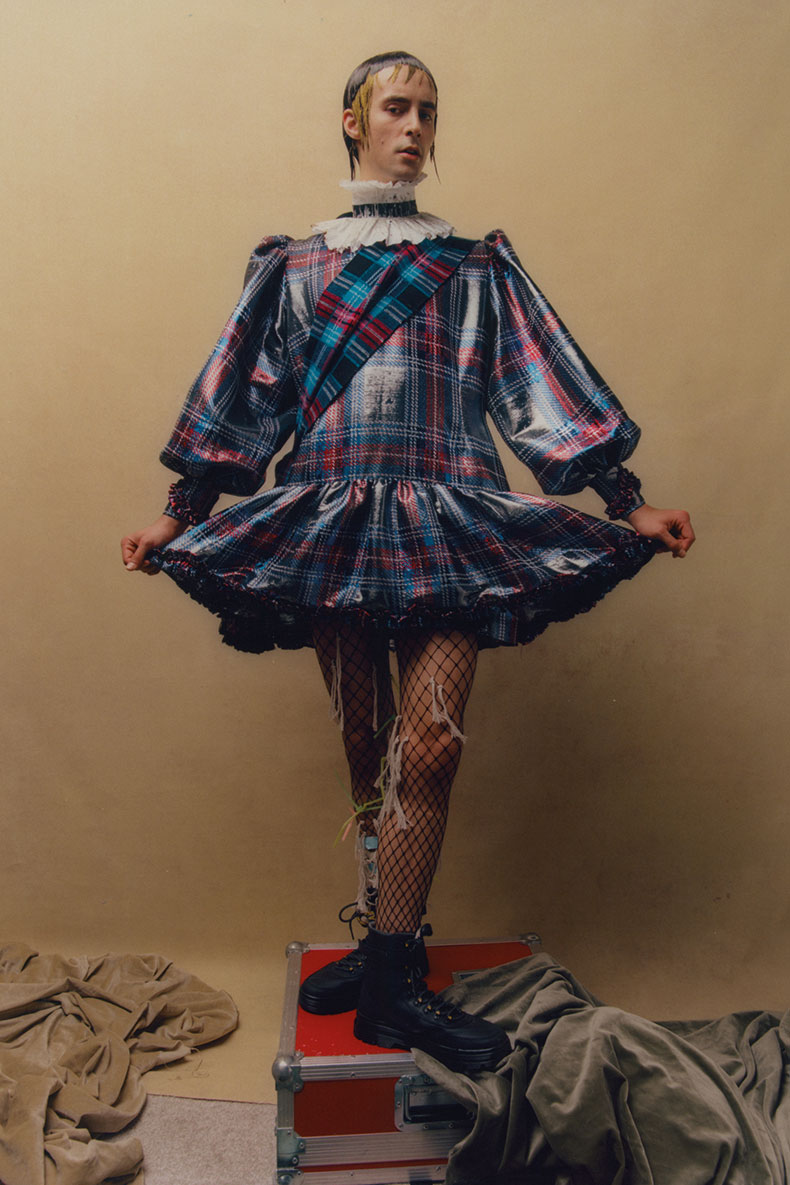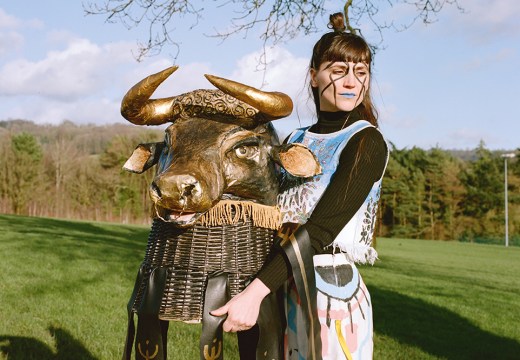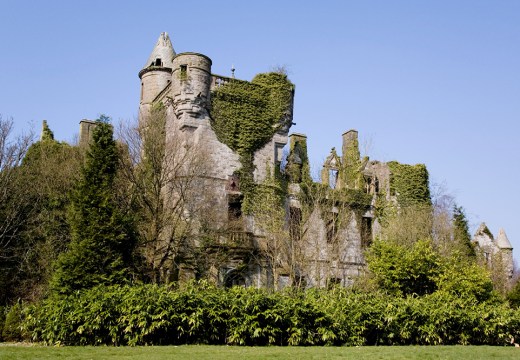From the May 2023 issue of Apollo. Preview and subscribe here.
An exhibition of many rooms and more than 300 objects mostly in tartan, most of them from north of the border, and almost all from these islands, in a Scottish museum: the curators of this fine and thoughtful exhibition can rest untroubled by demands for restitution. There are, in fact, a few pieces from abroad: a blue, red and white shuka (blanket) from Tanzania that looks suspiciously like tartan must raise the question of what makes a tartan a tartan, and not just a checked woven fabric. According to Jonathan Faiers’s excellent book Tartan (2008, revised 2021), upon which the exhibition is based, mummies exhumed in Xinjiang province, China, wore textile with a plaid pattern; and such is the scale of the folklore arising from this fabric that the discovery led some to conclude not, as you might suppose, that a check is the simplest woven pattern to make with two yarns of different colours, but that the original inhabitants of Xianjiang province must be of Indo-European origin.
The exhibition repeatedly poses this question of what a tartan is, and never quite answers it. The closest we come is a description of the process, certainly not unique to Scotland, of weaving together the warp thread and the weft thread in different quantities and colours. What is unique to Scotland is that the resulting pattern is then established as a discrete ‘sett’, which can be scaled up or down as long as the proportions remain the same. The principle is illustrated by a film from 1938 of Willie Meikle – one of the last handloom weavers of his generation and the presiding genius of the show – at his loom turning jewel-coloured reels of yarn into cloth, along with his reference library of woven tartan strips, rolled and pinned with handwritten labels, on shelves that reach to the roof. However, the most imaginative response to this rule of proportion is surely The Manhattan Tartan Project of 1999. The inspired enterprise of American artists J. Morgan Puett and Suzanne Bocanegra, this translated economic, topographical and demographic information into cloth, creating a tartan data bank of the city. To give just one example: for Manhattan Financial Tartan no. 599, each thread-colour represents a certain income bracket (silver = earnings over $100,000 per annum), and the incidence and extent of the colour is determined by the distribution of these wealth brackets from north to south.

A modern take on tartan from the Charles Jeffrey LOVERBOY Spring/Summer 2022 collection. Photo: Louie Banks; © courtesy V&A Dundee
Tartan has a complicated relationship with British politics. The proscription of the ‘plaid’ in 1746 as a blazon of Highland bolshiness, following the defeat of the Stuart army under ‘Bonnie’ Prince Charlie at Culloden, was not a simple thing. In the first place, there were exemptions, in the form of the military, the Lowland Scots (perceived as more loyal to the Crown) and the English. Moreover, responses to the ban were many and some of them unforeseen. One straightforward consequence was the immediate association of tartan with the lost Stuart cause – as one sees here, in portraits of young and sometimes mythical ‘lairds’ decked in tartan from head to toe – and in the resulting ‘tartanisation’ of images of the culturally Italian young pretender, whose portraits were sent to Scotland to tartan them up with a checked bonnet or length of plaid. Less obvious was the enthusiastic uptake of tartan, as the reality of the Stuart threat receded, as a resort for romantic-minded Englishmen. It was they, not the Scots, who campaigned for the ban on Highland dress to be rescinded, they who founded the improbably named Highland Society of London, who kitted themselves up in full tartan regalia and sang Scots ballads at their get-togethers. Absorbed into the ruling class, tartan swiftly became the servant of Hanoverian propaganda, a useful emblem of the unity between Scotland and England. And this reversal of fortunes in so short a time allowed the tartan to assume a singular capability. It could now represent wholly contradictory ideas: rebellion and conformity, gentility and brutality, country fields and city streets, extreme heterosexuality (‘A man in a kilt is a man and a half’) and extreme queerness: all of which have their moment here.
Given the size of the exhibition and the many and conflicting claims for the purpose of tartan, it perhaps makes sense to imagine the exhibition as a type of tartan itself. If it were, it would be a complex one, akin to Ogilvie of Airlie with its 180-odd colour changes; and woven from such threads as: tradition, design, craft, romanticism, fashion, Walter Scott and the visit of George V to Edinburgh in 1822, Queen Victoria and her ‘Balmoralisation’ of the British Crown. Crosswise, we have the defeat at Culloden, soldiery, rebellion, spectacle and performance, folklore, fantasy, commerce, queerness and outrage. These elements repeat and interweave, show their front and also their inverse planes, where colours reverse and merge in murky combinations. Hence, in the second room, we encounter the notorious Vestiarium Scoticum: a dubious compendium of ‘clan tartans’ worked up by the wholly self-invented ‘Sobieski Stuart’ brothers (real name Allen) in the early 19th century. A work of largely fantastical taxonomy, this nevertheless boosted demand for named tartans and promoted the founding of tartan mills and the fashion for tartan overseas. Following that, we see how the fabric and its naming system, which allows us to establish a pattern as our own personal brand, has interacted with fashion; so that the designer Charles Jeffrey, who designed and registered his ‘Loverboy’ sett, can stamp his identity on costumes at different points on a spectrum of orthodoxy, from a snazzy gents’ three-piece to a metal-thread Highland-themed post-punk fantasy garment, gathered at the chest with a great leather belt, and eliding elements of biker boy and the fhéilidh-Mor, the traditional belted plaid.
From early times, exponents of what Quentin Bell called ‘conspicuous outrage’ have identified tartan as a likely material for their cause. Parisian fashion plates from 1814 picture those gorgeous mode-rebels of the First Empire, the Merveilleuses, with tartan bodice and chewed sleeves. When the cloth became synonymous with conformity, hypermasculinity and imperial ambition, the obvious thing to do was to rip it up, swirl it about, and put it back together again as rags and tatters, as in Vivienne Westwood’s skirt of 1991; or turn it into a drag queen’s gimp suit like the ‘tartan eleganza’ sported by Violet Chachki, 2015 winner of Ru Paul’s Drag Race. Ultimately the show is very much a case of choose your poison, squire: Anglomania? Tick. Anglophobia? Double tick. And if anyone wants to know what a Scotsman wears under his kilt, the question has its own dedicated display.
‘Tartan’ is at V&A Dundee until 14 January 2024.
From the May 2023 issue of Apollo. Preview and subscribe here.
Unlimited access from just $16 every 3 months
Subscribe to get unlimited and exclusive access to the top art stories, interviews and exhibition reviews.














![Masterpiece [Re]discovery 2022. Photo: Ben Fisher Photography, courtesy of Masterpiece London](http://www.apollo-magazine.com/wp-content/uploads/2022/07/MPL2022_4263.jpg)
It’s time for the government of London to return to its rightful home